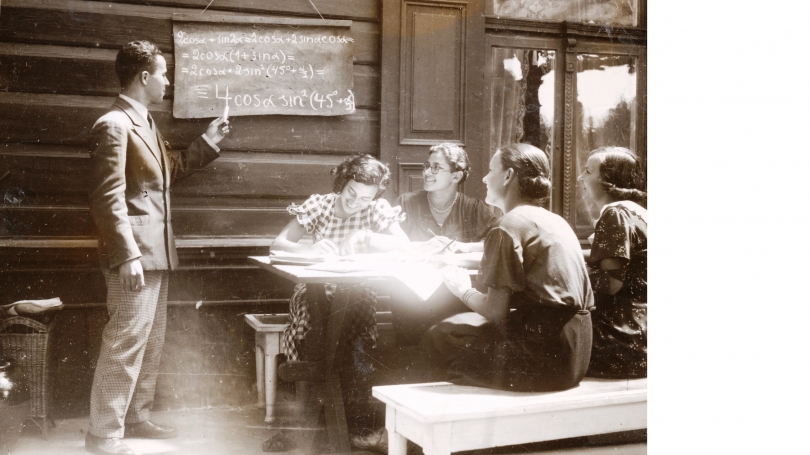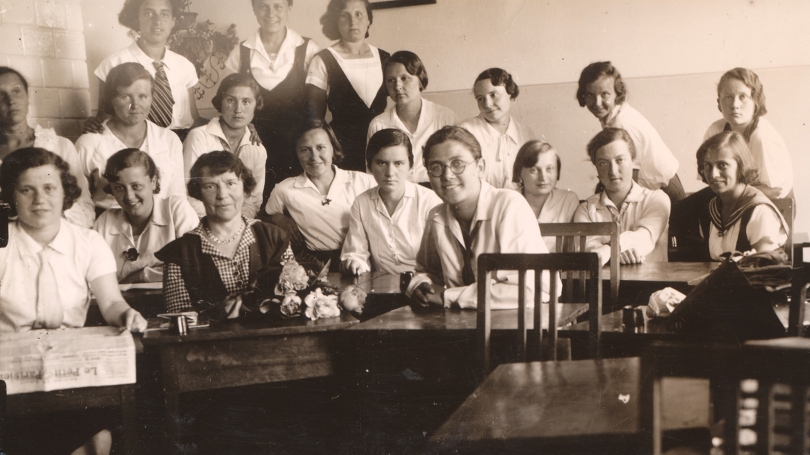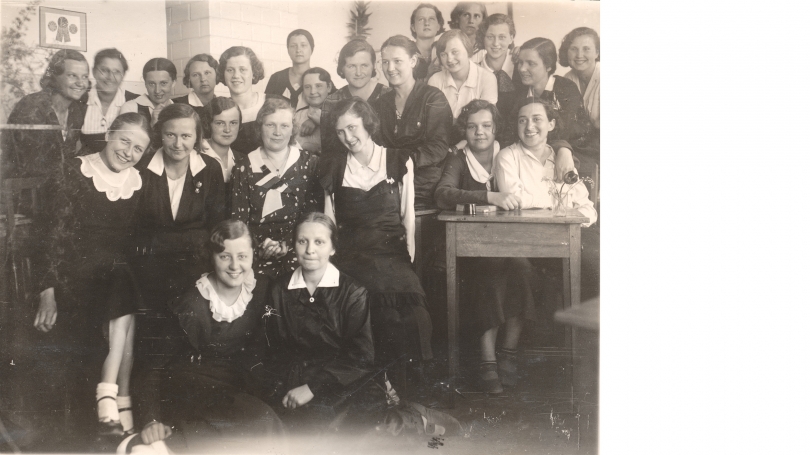In 1934, in Siedlce, Poland, a group of young girls are studying for their Matura—the centralized state exams that would certify their high school graduation.
Their school, the Queen Jadwiga School was a progressive public girls' school in Siedlce, a town 90 kilometers east of Warsaw. Cypora Jablon Zonszajn, one of only five Jewish students in her grade, and her Catholic friends Zofia Olszakowska-Glazer and Irena Zawadzka attended this school from age ten through their graduation in 1934. Their friendship is a testament to the pockets of cohabitation, tolerance, and integration in Poland and throughout Europe in the years preceding the Second World War.
In this photo (slide 1), we see the girls' love of learning in the context of friendship and community. We see ambition, hope, and joy shared among classmates.
During this period, the school's photographer was Adolf Gancwol-Ganiewski.
The Olszakowska family's relative affluence (Mr. Olszakowska was a pharmacist) also allowed the girls to use the family's camera to capture their rich lives during and after school in pictures. The photos of Siedlce in the interwar years reveal a group of young Jews and Catholics engaged in activities similar to those of teenagers today: playing volleyball, swimming, dressing up, studying, and having sleepovers.
Cypora, Zofia, and Irena all attended university in Warsaw after graduation. But from 1935 to 1937, deeply anti-Semitic nationalist groups led waves of violence against Jews in Poland. Universities established quotas to limit Jewish students and forced those enrolled to sit on "ghetto benches," or pews at the side of the classroom.
Zofia received a scholarship and went to Sweden to study economics; Irena went to Paris to study Romance Languages; and Cypora, who was studying agriculture, tried living in Vilnius, Lithuania, in hopes of avoiding anti-Semitic persecution. She met and married Jakob Zonszajn (also from Siedlce). As conditions in Europe grew more threatening for Jews, the couple moved back to Siedlce to be with their parents.
After the Nazis occupied Poland, Cypora, Jakob, and their families were confined to a ghetto in Siedlce surrounded by barbed wire on October 1, 1941, the very day that Cypora gave birth to a daughter, Rachel. By late August of 1942, when Rachel was ten months old, a multiday Aktion was carried out in Siedlce resulting in the execution or deportation to Treblinka of tens of thousands of the town's Jews.
Cypora and her baby survived the terrible days by hiding in an attic, but she knew that the only chance for Rachel's survival lay outside the ghetto. One night, she and Rachel escaped and fled to the home of her school friend Irena Zawadzka. Irena and her mother, Sabina, welcomed them, and Zofia, who was working in the anti-Nazi Polish resistance, soon joined them. Cypora believed that she looked too Semitic to pass as Aryan and, after hiding for a few weeks, returned to her husband in the ghetto. She left baby Rachel with her friends. Neither Cypora nor her husband survived.
At grave risk, Irena and Zofia became Rachel's adoptive mothers and loved her like their own daughter. They wished to keep her after the war, but Rachel's uncle Shimon, Cypora's brother, wanted Rachel to be sent to join him in Israel. Rachel moved to Kibbutz Ma'abarot, where she eventually raised two sons. She moved to New York in the 1990s and died in 2003.
In 1988, Irena and Sabina Zawadzka and Zofia Olszakowska-Glazer were named Righteous Among the Nations by Yad Vashem, Israel's official memorial to the victims of the Holocaust.
Judith Greenberg, cousin of Rachel Jablon Zonszajn and author of the forthcoming Cipa's Echo: A Mother, a Daughter and a Holocaust Legacy, writes:
"I first saw these photos in 2007, when my mother and I visited Zofia Olszakowska-Glazer in her apartment in Warsaw. Zofia was 92, my mother was 70, and I was 41. We sat together and turned the pages of Zofia's photo albums, and I was surprised to discover that the photos did not look like sets from Fiddler on the Roof or the anti-Semitic and provincial town that I had imagined. They reveal pre-war lives of happy teenagers, of Jewish and Catholic friends, whose daily activities do not seem vastly different from those of contemporary teenagers. Before seeing the photos, I only knew about Cypora from reading her diary and from her descriptions of the Siedlce ghetto in 1942. Zofia's photos provided a window into a completely different world in Siedlce during the optimistic and relatively tolerant period of Poland's interwar years.
In the process of researching the traumas and tragedies that followed these photos, I met Zuzanna, Zofia's granddaughter. Zuzanna and I wrote letters, exchanged emails, and then visited each other in Warsaw and New York. A deep friendship grew. Over the years and many trans-Atlantic voyages, our friendship has spread to include our extended families—husbands, children, parents, and siblings—and I cannot imagine life without Zuzanna. An aura of Cypora, Zofia, and Irena, the young friends from Siedlce, seems to surround us as we share our own lives and as we confront present day political threats and challenges."
Zuzanna Rudzińska-Bluszcz, granddaughter of Zofia Olszakowska-Glazer, writes:
"At first sight, this photo of girls during their math lesson is about youth: endless possibilities, the everyday opportunities to discover the world, and the period to forge the closest connections to others. Their emotions are high, their laughter sincere and loud, and they show great affection for their math teacher who seems to be at the center of the universe. Who hasn't been there? But there is a shadow hanging over this photo, the darkness that will inexorably come in a few years. WWII. We now can see what that shadow portends, but could they?
I grew up looking at my grandmother's pre-war photos. They carry a heavy history that I came to understand only after she died in 2007, when I returned to look at the albums alone. Each photo is alive to me. I hear the laughter when the girls have a snow fight, feel the sun on their bodies jumping into the river, see the excitement when they dress up at my great grandmother's house. I know the name of each friend and which men she loved. And I have a kind of omniscience, knowing what happened to all of them as they all vanished over the decades. Some of the people in these photos were part of my childhood and youth as my grandma's friends, regularly coming over to her for an apple pie and semisweet red wine. Some, like Cypora, died long before I was born. Strangely, this never made a difference: I call my grandma's Siedlce friends as "panienki," Polish for ladies, and consider those I met and never met as inseparable. Now they live in my heart, as they did in my grandma's. The question is whether I will be able to pass this affection on to my son."
In 2019, the Forum for Dialogue documented the visit of Cypora's family to Siedlce and their meeting with current students in the Queen Jadwiga School.
With thanks to Judith Greenberg, Class of 1988, and Zuzanna Rudzińska-Bluszcz. All images Courtesy of Zuzanna Rudzińska-Bluszcz.





